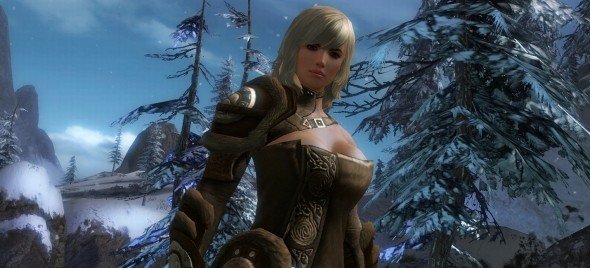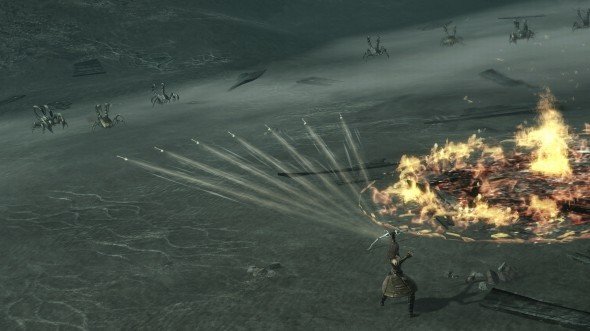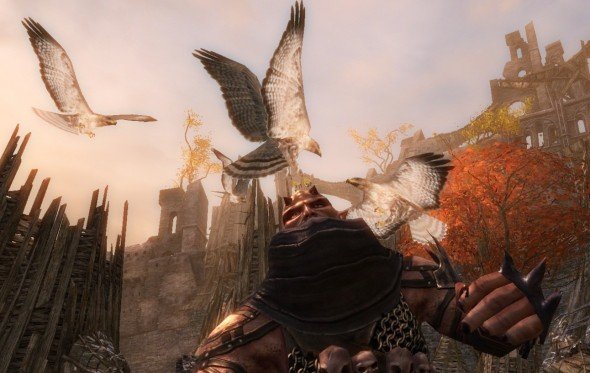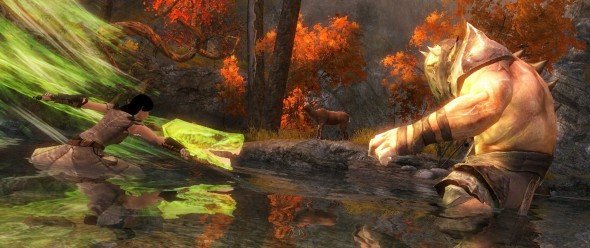Interview: meet Guild Wars 2's acrobatic Ranger

Subscription-free MMO Guild Wars 2 has just announced its third confirmed class: the Ranger. I spoke to lead designer Eric Flannum about the profession a few weeks ago, so we've been sitting on some exciting details about her (or him) until the grand reveal. She's still a primarily ranged class with a pet and traps, but the way she moves in combat, and the way her pets evolve, is very different. Eric's answers paint a great picture of how weapon and class choice combine to create very specific play styles. In Guild Wars 2, the same sword can serve completely different purposes in the hands of different professions.

PC Gamer: So what's the Ranger class all about?
Eric Flannum: The Ranger is nature based, primarily a ranged attacker. Rangers are special because all Rangers have a pet. In your biography you will get to choose between three different pets that you can start with, and that varies between race. Then you can have up to three pets, and you go to a pet management screen to pull out any of the three that you want - provided that you're not in combat. And so what we wanted to do is encourage Rangers to have up to three pets that they nurture and adventure with, and those three pets can be very different, purpose-wise.
So I can have maybe a bear who is good at tanking, or a snow leopard who's a good damage pet, and then maybe a Moa bird who's a good support pet, depending on the situation I'm in. So say I'm grouped with a bunch of Warriors and I really don't need a bear to tank, I can pull out my snow leopard. If I wanted some support I could pull out the Moa. And so Rangers are designed to have those choices with their pets, where the pets fulfill very specific roles.
The pets automatically level to the level of the Ranger, so you don't actually have to level pets. So if you get to level 50 and you want to go get a new type of pet, you don't have to spend a bunch of time levelling that pet. The pet's going to basically be effective.
The pets do have a thing that we call Evolution Levels. We had that concept in Guild Wars 1, but it's a little bit different in Guild Wars 2. In Guild Wars 2 Evolution Levels give the pet extra bonuses. One of the things you can do is the pet has a certain number of skill slots, and you unlock those skill slots as you go. Then you can slot skills into those slots for the pet. So like I said, the Moa bird is a support pet that has a bunch of squawks that do different things, and you can choose which of those things you want to slot. As your pet evolves you can slot more of them.
The Ranger is primarily a ranged character but he's also very effective with melee. So you can use a greatsword, sword and dagger, sword and warhorn - all of these things. So you can build a Ranger who switches between ranged and melee, or you can build a solely melee ranger, or you can build just a pure ranged Ranger.
The biggest gaming news, reviews and hardware deals
Keep up to date with the most important stories and the best deals, as picked by the PC Gamer team.

PC Gamer: What ranged weapons can he use?
Eric Flannum: The Ranger can use a longbow and shortbow, which are very different. Longbow, as the name implies, is a stationary, slow, long ranged weapon, and a shortbow is a very quick skirmishing weapon. Rangers can also use axes which for them are a ranged weapon, so Ranger axe skills tend to be just all about throwing axes - that's kind of a short range weapon for them.
Warhorn also has a little bit of range on it. The warhorn is a little different, in that most other professions that use a warhorn use it solely for buffing. The ranger can use it to call in temporary animals to attack things. My personal favourite skill in the game is a warhorn skill that summons in three hawks that dive in and start ripping at the target.
PC Gamer: If the Ranger is using a melee weapon, how are their skills different from a Warrior using the same weapon?
Eric Flannum: That's a good question. So let's take sword: With a one handed sword, the first skill the Warrior gets is a combo that causes a lot of bleeding and has a big hit at the end - it's a three part combo. One of the things we have is combination skills, where you hit the skill and it changes to be skill 2, then skill 3, and then cycles back to skill 1. So the Warrior has two bleeding skills and a big finishing skill in his first skill slot.
His second skill slot is Flurry which is an area-of-effect skill: you hold it down and it does a rapid series of hits. And his third one is Savage Leap, which is a movement skill where he leaps at his foe. So the Warrior with the sword is all about causing bleeding and chasing down targets that are trying to run from him.
The Ranger, on the other hand, is very, very mobile with a sword – a lot of the Ranger's attacks with swords move him in some way. So his three part combo with the sword is; he has a basic attack, and then he has a kick as the next part which kicks the opponent away from him, and then his third one is a follow-up leap attack. His second skill is called Hornet Sting, where he attacks the opponent and then rolls back. And his third one is Serpent Strike, in which he rolls around to the back of an opponent and then poisons them with Serpent Strike.
So the thing you'll get with a Ranger attacking with a sword is a lot of movement, and you can use that movement to really good effect. In fact one of the really cool combos you can do with Ranger is: say you've got a sword and a shortbow. You can use your combo up to the second attack, where you kick the guy away from you, and then not do the third part. But instead use skill number 2, Hornet Sting, which will cause you to roll backwards - so you've just created a ton of distance between yourself and the guy you're fighting. You can then immediately swap to the shortbow and use a cripple on them, and try to kite them with the bow.
So that's the difference.

PC Gamer: So it's pretty acrobatic?
Eric Flannum: Yeah, so the Ranger's a lot more acrobatic with his melee weapon.

